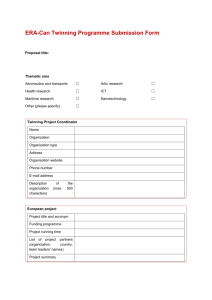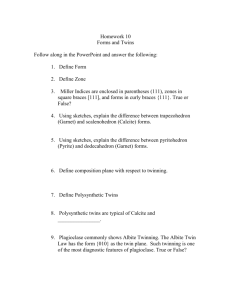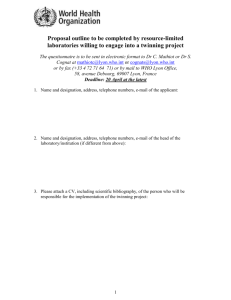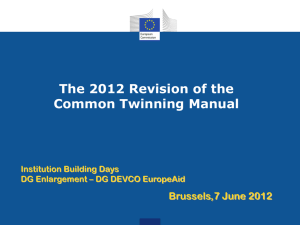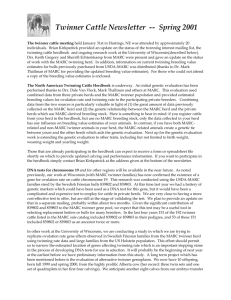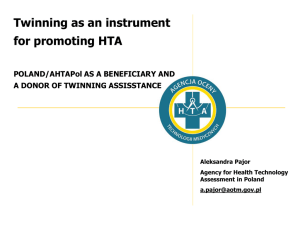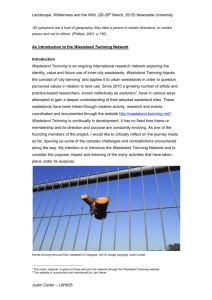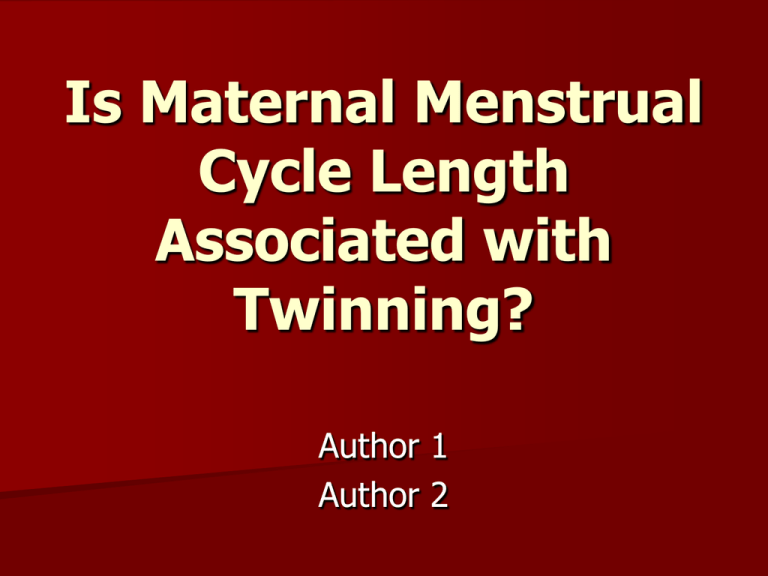
Is Maternal Menstrual
Cycle Length
Associated with
Twinning?
Author 1
Author 2
Background
Menstrual Cycles & Twinning
– Shorter cycles -- ↑ Twinning
Time to Pregnancy (TTP) & Twinning
– ↓ TTP -- ↑ Twinning
Menstrual Cycles & Fertility
– Regular menstrual cycles -- ↑ Fertility
– Short & long cycles -- ↑ Spontaneous abortion
Body Mass Index
– ↑ BMI -- long, irregular cycles
– ↑ BMI -- ↑ twinning
Why this question?
Goal to determine whether menstrual cycle
characteristics can act as a surrogate for
reproductive health
“Natural” twinning trends may be used as an
indicator of reproductive health
Unique cohort to study twinning
– 223 Twins
– Before ART and OC use were common
Menstrual cycle length was asked before birth
outcome (less recall bias)
Study Population
In iti a l D a ta set
N= 2 05 30
Mis s ing Men s tr u al C y cle L ength (N = 8847)
M en str ua l Cycles
N= 1 16 83
O r al con tra cep tion (N = 66 8 )
N o Or a l Co n tr a ce p tio n
N= 1 10 15
M e d ica tions fo r th y ro id, fer ti li ty, o r any
oth e r ho r mo n al m ed ic a tion (N=1 58 4)
N o Ot h er H o rm ona l M ed ic a tion s
Fi na l D a ta set
N= 9 431
97 Twins
Disc o rdan t S ex T w in s D a ta set
N= 9 465
31 Twins
Sa m e sex tw ins (N=66)
Exposure & Outcome
Menstrual Cycle Length:
– Short (<25 days)
– Average (25-35 days)
– Long/Irregular (> 35 days)
Twinning:
– In CHDS: 223/20307 births (1.07%)
– Final dataset - 97 twins
– Discordant sex twin dataset - 31 twins
Univariate Analyses
Age*
Race*
Education*
Pre-pregnancy BMI
Current BMI
Smoking status*
Cigarettes/day*
Alcohol use
Coffee intake*
Tea intake
Age of menarche*
Pregnancy outcome
Parity
Interval between
pregnancies
* Associated with menstrual cycle length
Associated with twinning
Chi Square Analyses
Number and percents of singletons and twins for each category of menstrual
cycle length, Child Health and Development Studies, Oakland, CA, 1959-1967.
Menstrual Cycle Length
Outcome
Singletons
Twins
Short
n=597
(6.3%)
Average
n=6639
(69.7%)
Long/
Irregular
n=777
(24.0%)
575 (98.1)
6492 (98.9)
2267 (99.4)
11 (1.9)
73 (1.1)
13 (0.6)
Pvalue
9.3
0.01
Bivariate Analyses
Proportion of Twinning (%)
Characteristic
All
Short
Cycle
n=586
Average
Cycle
n=6565
StratumSpecific
RR
(95% CI)
1.9
1.1
NA
Education
<= High School
0.7
1.0
0.7 (0., .7)
> High School
3.2
1.2
.6 (1.3, 5.3)
Log likelihood test: Wald =3.88 p=0.14
MantelHaenszel
RR
(95% CI)
BreslowDay Test
for
Homogeneity
1.7 (0.9, 3.2)
NA
NA
3.2 (0.1)
Bivariate Analysis
Proportion of Twinning (%)
Characteristic
All
Long/
Irreg
n=2280
Average
Cycle
n=6565
StratumSpecific
RR
(95% CI)
0.6
1.1
NA
Age
<20
0.8
0.0
NA
20-24
0.3
1.1
0.2 (0.1, 1.1)
25-29
0.4
1.2
0.3 (0.1, 1.1)
30-34
0.8
1.4
0.6 (0.1, 2.5)
>34
0.8
1.4
0.6 (0.1, 2.5)
Log likelihood test: Wald =12.0 p=0.21
MantelHaenszel
RR
(95% CI)
BreslowDay
Test for
Homogeneity
0.5 (0.3, 0.9)
NA
NA
9.7 (0.1)
Multivariable Analyses
Crude Model
Odds Ratio
95% CI
Short
1.70
(0.90, 3.23)
Long/ Irregular
0.51
(0.28, 0.92)
Multivariable Analyses
Crude Model
Odds Ratio
95% CI
Short
1.70
(0.90, 3.23)
Long/ Irregular
0.51
(0.28, 0.92)
Short
1.83
(0.96, 3.51)
Long/ Irregular
0.53
(0.29, 0.98)
Age
1.01
(0.98, 1.05)
Pre-pregnancy BMI
1.10
(0.64, 1.90)
Race
1.41
(0.92, 2.16)
Parity
1.99
(1.09, 3.63)
Smoke
1.52
(0.99, 2.33)
Age of menarche
1.36
(0.83, 2.22)
Adjusted Model
Multivariable Analyses
Crude Model
Odds Ratio
95% CI
Short
1.70
(0.90, 3.23)
Long/ Irregular
0.51
(0.28, 0.92)
Short
3.08
(1.24, 7.63)
Long/ Irregular
0.39
(0.12, 1.31)
Restricted to Different Sex Twins
Conclusion
Found association between menstrual cycle
length and twinning
Limitations include the large amount of missing
data
Potential confounders did not change the
estimate of the effect
Interaction was not significant
Future Directions
Restricted
Data Set
DZ
♀♂
Potential
Exclusions
DZ
MZ
MZ
♀♀
♀♀
♀♀
♂♂
♂♂
♂♂

